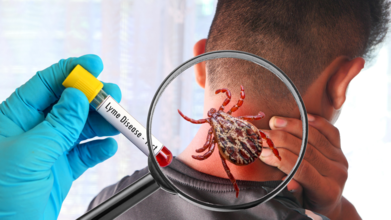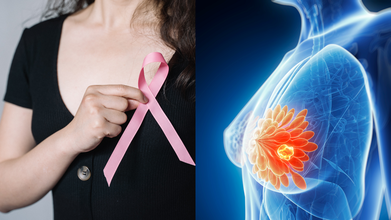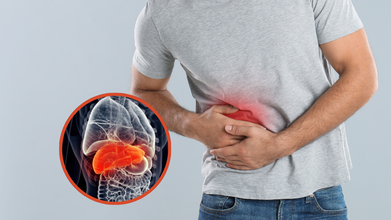- Health Conditions A-Z
- Health & Wellness
- Nutrition
- Fitness
- Health News
- Ayurveda
- Videos
- Medicine A-Z
- Parenting
- Web Stories
Researchers Are Linking An Active Social Life To Alzheimer's; The Connection Will Shock You

(Credit-Canva)
A disease that affects our memory and cognitive abilities, Alzheimer’s disease, is the most common among all dementia diseases. Dementia is an umbrella term used to define progressive cognitive disabilities. A common sign of Alzheimer’s you may have heard of is forgetting things frequently, however, there is much more to it than that. This disease changes the way a person functions, whether it is memory, thinking skills, or behavior.
For a long time, feeling lonely was seen as a big sign of Alzheimer's disease. But new research from the University of California, looking at half a million people in the UK, is now questioning this idea. The study checked people's genes and social habits. Surprisingly, it found no real difference in how lonely people felt or the quality of their friendships between those with a high risk for Alzheimer's and those with a low risk.
In fact, people with a higher genetic risk actually spent more time doing social things and had happier family lives, reporting much less loneliness. This has led scientists to think that Alzheimer's might actually make people more social in its early stages, instead of less.
Complex Link Between Sociability and Dementia
Researchers are now trying to figure out why people with a higher genetic risk for Alzheimer's might be more social. Maybe they are actively trying to meet more people, or perhaps those around them notice small changes and offer more help. It's important to know that dementia is a general term for different brain problems, including Alzheimer's, where brain function slowly gets worse.
Right now, over 944,000 people in the UK have dementia, affecting about one in every eleven people over 65. While there's no cure for Alzheimer's yet, there are treatments that can help with problems like confusion and memory loss.
Lifestyle Factors and Dementia Prevention
Even though we need more research on the link between dementia and social behavior, experts still believe that being more social could help lower the risk of dementia. This is because being connected to others is thought to make your brain stronger, helping it work well even as you get older.
Also, past studies suggest that almost half of all dementia cases could be prevented by making lifestyle changes. For example, recent research from Oxford University in 2024 found that things like pollution, drinking alcohol, and being very tired increase the risk of dementia. Type 2 diabetes was also highlighted as a big risk factor, possibly damaging sensitive parts of the brain.
Understanding Dementia Symptoms
The signs of dementia can be different depending on the type. In the early stages, common signs might include difficulty doing everyday tasks you're used to, like getting confused about change when shopping. Other signs often include forgetting things, struggling to follow a conversation or find the right words, feeling confused about time and place, experiencing mood changes, and having trouble focusing.
If you think you or someone you know might have these symptoms, it's very important to talk to a doctor. Getting an early diagnosis, even without a cure, can sometimes help slow down the disease, allowing people to stay mentally sharp for longer and prepare for the future.
Unique Symptoms Of Lyme Disease In 2025 And How Long Infection Now Last

Credits: Canva
Vax-Before-Travel, an international publisher of vaccine information noted that in 2025 Lyme disease ticks have progressed westward into many midwestern states. It has also reported a significant increase. However, while the Tick Season is back, there is a new Lyme treatment on the horizon. But, with it, there are also unique symptoms that one has to be aware of.
Unique Symptoms Of Lyme Disease In 2025
The ongoing threat of ticks is usual when one is enjoying their time as the weather warms up. They can be found in your backyard and can transmit Lyme disease, a tickborne infection caused by the bacteria Borrelia burgdorferi.
While Lyme disease is usually resolved with a short course of antibiotics, it is not always a simple illness. Sometimes, it can lead to prolonged symptoms, if untreated.
As per American Medical Association (AMA), Lyme disease is the most common vector-borne disease in the US, with an estimated 476,000 people diagnosed and treated each year. The numbers are also corroborated with the Centers for Disease Control and Prevention (CDC).
The Maryland Government Health website also notes that for about 75% of those diagnosed with Lyme disease, the first sign is always a skin lesion. This appears within one to four weeks after being bitten by an infected deer tick. However, only about 20% of these lesions take on the classic bull's eye appearance, which is most commonly associated with Lyme disease. This means, 55% of those with lesions may not even be diagnosed with the condition, and may not get the treatment.
ALSO READ: Lyme Disease In US: How Worried Should You Be Of Ticks?
Here Are 7 Unique Symptoms Of Lyme Disease
Heart Problems
The Time reports that if Lyme is not treated early on, it can impact the cardiac, neurologic, and rheumatologic systems. The CDC notes that 1 out of 100 patients have Lyme bacteria in their heart tissues. The condition is also called Lyme carditis.
This leads to heart inflammation, light headedness, fainting, shortness of breath, heart palpitations, or chest pain.
Brain Fog
John Hopkins Medicine Lyme Disease Research Center notes that advanced brain imaging shows that Lyme disease brain fog is real. It can lead to various brain effects, including difficulty in focusing, thinking, reading, and absorbing information.
Bell's Palsy
There are 12 essential nerves, also known as the cranial nerves that originate in the brain and play an important role in sensory functions and movements in the different parts of the head, face, neck, and torso. Lyme disease can also affect those nerves, leading to Bell's Palsy, causing sudden weakness or even paralysis.
Eye Problems
Some people may experience eye irritation and conjunctivitis. The American Journal of Medicine's 1995 study also suggests that Lyme can cause sudden vision loss, damage to optic nerve, and neurotrophic keratitis (decreased corneal sensation). Other symptoms include blurry vision, eye floaters, tearing and extreme sensitivity to light.
Hearing Problems
A 2018 study published in Otolaryngologia Polska, reported of the 216 people with tickborne disease, 162 experienced otolaryngological symptoms—making them a “frequent manifestation,” according to the study authors. The most common hearing issues are tinnitus, vertigo and dizziness, headache, and unilateral sensorineural hearing or hearing loss in one ear.
Arthritis
It is one of the common symptoms of Lyme disease, especially in young people. It can be seen in form of a swollen knee, a low grade fever, or a kid limping. It usually starts at a fourth week of being bitten.
On a hopeful note, researchers at Northwestern University in Illinois recently screened over 500 antibiotics and FDA-approved compounds to identify treatments that specifically target the unique cellular makeup of Borrelia burgdorferi, the bacteria behind Lyme disease.
Their findings, published in Science Translational Medicine, revealed that piperacillin, an antibiotic from the penicillin family, successfully cured mice of Lyme disease at doses 100 times lower than doxycycline, the standard treatment currently in use.
Fatigue
This is not just any fatigue, but a weakness that is debilitating. A 2022 study published in the International Journal of Infectious Diseases noted that people with a history of Lyme were 8 to 15 times more likely to report severe or moderate fatigue than those who have never had the disease.
READ: Family Shares How A Lyme Disease Misdiagnosis Cost Their Son's Childhood
How Long Do These Symptoms Last?
As per the National Health Service, (NHS), UK, in case of a rash, it can appear up to 3 months after being bitten by an infected tick. However, in most common cases, it appears within 1 to 4 weeks, and stays for several weeks.
In cases of untreated Lyme disease, the symptoms may appear later, and may become chronic, like debilitating fatigue.
More Than Just Shrinking The Tumour: Expert Tells How Neoadjuvant Therapy Changes The Game In Breast Cancer Treatment

Credits: Canva
Breast cancer has a strange way of being both familiar and frightening. Almost everyone knows someone who has battled it, and yet the details of treatment often sound like an alien language. According to the World Health Organisation, breast cancer is the most common cancer among women worldwide, with 2.3 million new cases in 2022 alone. Among these, about 15 to 20 per cent are HER2-positive, the type that is fast-moving, aggressive, and hard to ignore.
Increasingly, the doctors are turning to a strategy that feels a bit like hitting “pause” before the main act—neoadjuvant therapy.
What Makes HER2-Positive Breast Cancer Tricky
HER2 (human epidermal growth factor receptor 2) is a protein that helps cells grow. In HER2-positive breast cancer, the cells get an overdose of this protein. As a result, the cancer multiplies faster than usual and is often linked to poorer outcomes.
“HER2-positive breast cancer is an aggressive type,” explains Dr Mandeep Singh Malhotra, co-founder, Art Of Healing Cancer. “It is very important to give the right information to patients and their families for better outcomes. With the right treatment sequence, it is possible to offer better treatment to patients.”
What Is Neoadjuvant Therapy?
Neoadjuvant therapy (NT) is like a warm-up session but for cancer treatment. Instead of rushing into surgery to remove the tumour, doctors first administer chemotherapy and targeted drugs. The idea is to shrink the tumour, make surgery easier, and gather valuable intel on how the cancer responds.
“Nowadays, when we talk about HER2-positive breast cancer, we talk about targeted therapy and dual targeted therapy involving both trastuzumab and pertuzumab,” says Dr Malhotra. Both are monoclonal antibodies, meaning they are lab-made molecules designed to stick to specific parts of cancer cells. Together with chemotherapy, they not only shrink tumours but also improve surgical outcomes.
Why Doctors Like It
One of the superpowers of neoadjuvant therapy is its ability to act as a kind of crystal ball. By giving treatment before surgery, doctors can tell which patients are “responders” and which are not.
“As Dr Malhotra puts it, “Even at early stages, if we give NT and then operate, we are able to prognosticate. Responders have a better prognosis. Non-responders have poorer prognosis and a higher chance of the cancer coming back.”
This ability to sort patients into risk categories allows doctors to tailor follow-up care more precisely. For example, non-responders may be put on more aggressive treatments, offered newer diagnostic tests like liquid biopsy, or monitored more closely.
The Big Advantage Over Surgery-First
Surgery-first and neoadjuvant-first have similar survival data, but the latter provides an extra layer of information.
“If we do upfront surgery in these patients, we lose the chance of prognostication,” says Dr Malhotra. “Secondly, even if we do the upfront surgery, we will still have to give chemo with targeted therapy after surgery. So the treatment does not change; the sequence changes. And with neoadjuvant therapy, we get the added benefit of knowing who is high risk and who is low risk.”
In other words, neoadjuvant therapy is not just about shrinking tumours; it is about outsmarting them.
What Patients Need to Keep in Mind
For patients, all of this can feel overwhelming. Surgery often seems like the most direct way to “get rid” of cancer, so the idea of delaying it can cause anxiety. But Dr Malhotra reassures patients that this approach is carefully designed.
“Even in very early-stage breast cancer, with a less than 1 cm tumour, I will not go for surgery first,” he says. “I will first give targeted chemotherapy. The reason is I see a lot of patients who have already had surgery and then are given the option of dual therapy. They are confused and afraid that the cancer will come back if they cannot afford either trastuzumab or pertuzumab.”
Interestingly, cost can also play a role. If patients achieve a complete response, meaning no invasive cancer remains after neoadjuvant therapy, sometimes treatment can be stopped earlier, sparing both physical and financial strain. “We lose this opportunity if surgery is opted for first,” Dr Malhotra adds.
The Future of HER2-Positive Breast Cancer Treatment
The shift towards neoadjuvant therapy represents a significant change in how doctors approach HER2-positive breast cancer. Instead of rushing in with surgery, the modern strategy is more like a chess game, carefully setting up each move to give patients the best possible outcome.
By combining chemotherapy with targeted drugs like trastuzumab and pertuzumab before surgery, doctors can shrink tumours, assess risk, personalise treatment, and often improve long-term survival.
Breast cancer treatment has always been a mix of science, strategy, and courage. Neoadjuvant therapy, especially in HER2-positive cases, is proving to be more than just a pre-surgery step. It is a game-changer, giving both patients and doctors a crucial edge in the fight.
As Dr Malhotra puts it, “Neoadjuvant therapy is not an inferior modality. With current data, we feel it is a superior one.”
Ortho Surgeon Reveals The Real Reason Behind This 29-Year-Old Woman's Stage 3 Fatty Liver Diagnosis - It Wasn't Alcohol

(Credit - Canva)
Just like any other office worker, this 29-year-old woman, followed the same routine, long working hours, morning coffee runs and often ordering out due to exhaustion, “The way she described it, it sounded normal. And that’s what worried me the most.” What her tests revealed shocked even her doctor, with alarming rates of liver enzymes, her ultrasound showed stage 3 fatty liver. The kicker is, she never touched alcohol in her entire life!
Dr Obaidur Rahman, ortho & sports surgeon, shared this story on his social media handle, to help spread awareness about nonalcoholic fatty liver disease (NAFLD) and the growing rates of the disease among young adults. NAFLD is also known as MASLD or fatty liver disease according to British Liver Trust.
While many people believe it is a disease on people who drink alcohol are susceptible to, this common misconception leads to many people overlooking the signs and symptoms, until it is too late.
What Are The Early Symptoms of Fatty Liver?
In the video caption, Dr Obaidur mentioned that the patient had faint yellow eyes, swollen legs that left deep impressions when pressed as well as slow unsure steps. He explained how these symptoms would be more in line with a patient decades older than the 29 year-old. According to UK National Health Services, most people who have it don't experience any symptoms and don't even know they have it. When symptoms do appear, they can include:
- Feeling very tired
- General discomfort or feeling unwell
- Pain in the upper right side of your abdomen, under your ribs
Can Bad Lifestyle Habits Cause MASLD?
MASLD is when fat builds up in your liver because of extra body weight, high blood sugar, high cholesterol or high blood pressure (John Hopkins Medicine). While doctors don't know the exact cause of MASLD, it is strongly linked to several common health issues.
Obesity: Carrying extra weight, especially around the belly, is a major factor.
Insulin resistance and Type 2 diabetes: This is when your body doesn't use insulin properly, causing blood sugar levels to rise.
Metabolic syndrome: A combination of conditions that include high blood pressure, high blood sugar, excess body fat around the waist, and abnormal cholesterol or triglyceride levels.
High cholesterol and high triglycerides: These are types of fats in your blood that, when too high, can contribute to liver fat.
Who Is At Risk for MASLD?
According to the American Liver Foundation, about 100 million people, which is around 25% in the US have been estimated to have MASLD. It is very common and certain factors make you more likely to get it. “Fuelled by sugar-laden “healthy” drinks, long hours of sitting, processed foods, and constant low-grade inflammation” Dr Obaidur details. Anyone could be at risk, some factors that determine that are:
- Are overweight, especially with a lot of fat around your stomach.
- Have a poor diet or don't get much physical activity.
- Have type 2 diabetes, high blood pressure, or high cholesterol.
- Are over 50 years old.
- Have polycystic ovary syndrome (PCOS).
What is the Treatment and Lifestyle Changes Needed for Fatty Liver?
The best way to treat MASLD is by making healthy lifestyle changes. These changes can help reduce liver fat and even repair some damage. They also lower your risk of other related health problems like heart disease and diabetes. Here's what you should do:
- Eat a healthy, balanced diet.
- Exercise regularly, aiming for at least 150 minutes a week.
- Lose weight if you are overweight.
Here's what you should avoid:
- Don't drink too much alcohol. Stick to the recommended limit of no more than 14 units per week.
- Don't smoke.
© 2024 Bennett, Coleman & Company Limited




